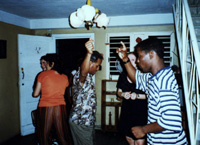
To get more friends, here are some few dances you should learn:
Samba
Samba is a popular dance from Brazil, and the music is a mixture of Spanish bolero with rhythms of African music. Drums are the main instrument. The dance can turn to be very erotic sometimes, and is characterised by drums (also other instruments), colourful costumes and advances steps. Dancing Samba is like turning the body around, twisting, jumping up and down. This is what the Brazilian do during their parades and carnivals.
Samba is shaped by influences from other continents and it is still developing. A theory is that the word Samba is inspired from the African word Zemba, which means "jump". Samba reaches its top of the popularity in the1930s. In the last years Lambada, influenced by Caribbean rhythms, has become popular all over the world.
Photo: The Samba is wild and erotic - Rio de Janeiro.
For they who like it hot.....
Photo: Dancing Salsa - Cuba.
Salsa
The word means sauce. Salsa is "son"; Afro-Cuban music with drumming spiced and mixed up with other Latin American rhythms as meringue, mambo, bolero, cha-cha-cha and rumba. Salsa is a dance based on these rhythms.
Salsa music has been rapidly spread around the world recently thanks to the excellent Cuban musicians from the group Social Bueno Vista Club.
Photo: Here you see an eager European tourist trying to learn Tango in Bueno Aires, Argentina.
Tango:
This dance is a tight and erotic dance for couples, emerged in the end of the 1800-century. Build up based on elements from older Latin American dances, flamenco and African rhythms.
Afro-dance
Intensive dance to drums, hard physical training and dynamic moves with the body. The dance is based on natural moves with the body.
Belly-dancing
The dance emerged for 2000-3000 years ago. The background for the dance is from old religious or pagan societies. The word was probably used for the first time in the 1800-century. Napoleon's men called this kind of dance for the "dance du centre" - dance with your belly. Arabian countries are famous for belly dancing. Wiggling the body around is seen as vulgar and a sign of promiscuity.
Be aware of that many of the dancers at belly-dancing shows at the resorts and tourist hotels, are in fact European or American. It is considered to be inappropriate for Arab women to behave so provocatively.
Flamenco
Flamenco is a choreographic dance, no instructed steps or moves. Intense stepping with feet, proud attitude with the body, moves the fingers and quick turnings. Gypsies from India launched the dance in Spain for many hundred years ago.
Photo: Dancing Flamenco in Barcelona.
Irish step dance
Step dance is a folkdance from Ireland, famous trough the dance show "Riverdance". Also called "the hard shoe dance". Impressing footwork with iron under the shoes. You can dance with a partner, in a group and on a line.
Norwegian traditional dance
There are several popular dances in Norway: reinlender, springpolka, bygdesving, vals (waltz) and masurka (mazurka). You can dance with a partner or in a group.
Katahak
Katahak is a traditional dance from the northern part of India. It is basically a temple dance, with rhythmic, advances footsteps and "swaying" movements with upper part of the body. The dance performs in colourful costumes.
Dancing represent a life style and a social function in many cultures. When you dance you feel common with others and that makes you happy together. It all depends how easy you find the harmony in rhythms and moves together with your partners. Exercise, exercise and again exercise is the only method to achieve a successful result.
Find a course at your local place to prepare a visit to another country, or take a dance course at the country you visit. I can guarantee that improved dancing skills will make it easier for you to get in better contact with people you meet around the world. Good luck!
Stein Morten Lund, 22 August 2000
